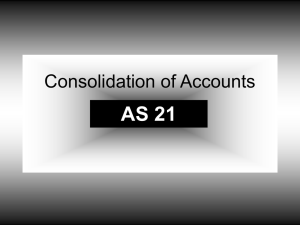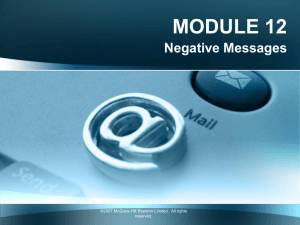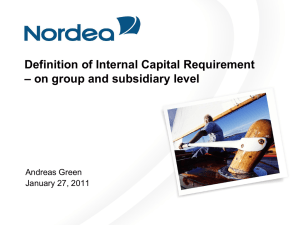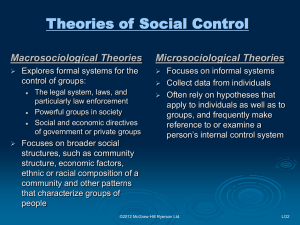Chapter Eight
advertisement
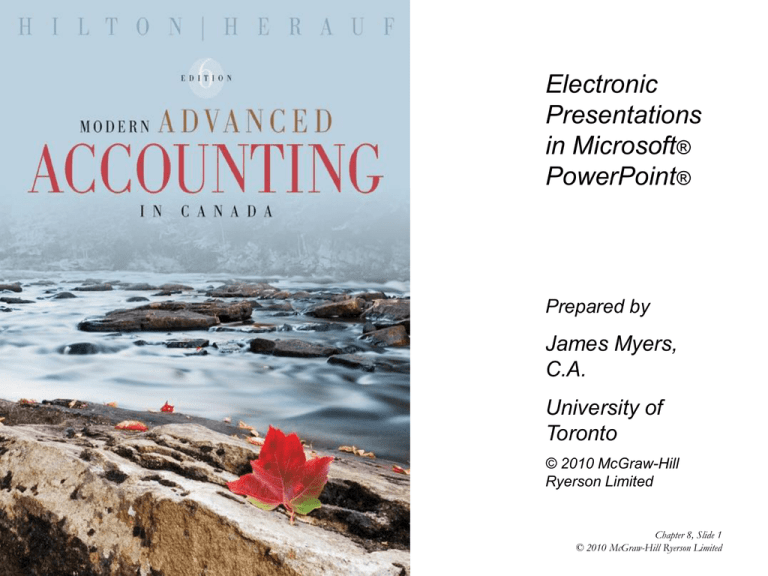
Electronic Presentations in Microsoft® PowerPoint® Prepared by James Myers, C.A. University of Toronto © 2010 McGraw-Hill Ryerson Limited Chapter 8, Slide 1 © 2010 McGraw-Hill Ryerson Limited Chapter 8 Consolidated Cash Flows and Ownership Issues Chapter 8, Slide 2 © 2010 McGraw-Hill Ryerson Limited Learning Objectives 1. 2. 3. Prepare a consolidated cash flow statement by applying concepts learned in prior courses and unique consolidation concepts discussed here Prepare consolidated financial statements in situations where the parent’s ownership has increased (step purchase) Prepare consolidated financial statements after the parent’s ownership has decreased Chapter 8, Slide 3 © 2010 McGraw-Hill Ryerson Limited Learning Objectives 4. 5. Prepare consolidated financial statements in situations where the subsidiary has preferred shares in its capital structure Calculate consolidated net income and non-controlling interest in situations where a parent has direct and indirect control over a number of subsidiary companies Chapter 8, Slide 4 © 2010 McGraw-Hill Ryerson Limited Consolidated Cash Flow Statement The consolidated cash flow statement must include the operating, investing, and financing cash flows of the corporate group, to the extent that these cash flows have taken place with parties outside of the combined group and not within the group Instead of combining the separate company cash flow statements of the parent and subsidiary which contain intercompany transactions, it is more practical to prepare the consolidated cash flow statement by using comparative year-end consolidated balance sheets and income statements LO 1 Chapter 8, Slide 5 © 2010 McGraw-Hill Ryerson Limited Consolidated Cash Flow Statements The following items arising from business combinations must be adjusted on the consolidated cash flow statement: LO 1 The cash, if any, paid for the acquisition of a subsidiary is presented net of the subsidiary’s cash acquired at that date The acquisition differential is amortized in the consolidated income statement but does not affect cash flows Non-controlling interest in the consolidated income statement is an allocation of the entity’s net income and does not affect cash flows Dividends paid by subsidiaries to the parent company do not change the combined entity’s cash. Dividends paid by subsidiaries to non-controlling shareholders are disclosed separately from dividends paid by the parent to its shareholders. Chapter 8, Slide 6 © 2010 McGraw-Hill Ryerson Limited Consolidated Cash Flow Statements In the period that a subsidiary is acquired: Cash paid to acquire the subsidiary, less cash held by the subsidiary, is netted and disclosed on one line under “Investing Activities” on the cash flow statement as: “Acquisition of subsidiary, less cash acquired in acquisition” LO 1 Details are disclosed in the notes to the financial statements including condensed balance sheet of acquired subsidiary disclosing the amount assigned to each major class of non-cash assets and liabilities of the acquired enterprise at the date of acquisition Chapter 8, Slide 7 © 2010 McGraw-Hill Ryerson Limited Ownership Changes Few intercorporate investments consist of a single purchase Investments are acquired as opportunities arise (“block acquisitions” or “step purchases”) and are sold directly to third parties as strategies change Subsidiaries may sell additional shares to the public, indirectly reducing the parent’s ownership percentage How do we account for acquisitions made in multiple stages or steps? How do we account for a direct or indirect reduction in the parent’s investment in a subsidiary? What effect do these have on non-controlling interest? LO 2, 3 Chapter 8, Slide 8 © 2010 McGraw-Hill Ryerson Limited Ownership Changes - Increases Available-for-sale investments (without significant influence) are recorded at the price paid for the shares and are adjusted to fair value through Other Comprehensive Income at the end of each reporting period After the first increase in ownership (“block acquisition” or “step purchase”) that results in significant influence, the equity method of accounting is used which requires an Acquisition Differential (AD) to be calculated and allocated based on fair values at the date that significant influence is obtained LO 2 For this calculation, the amount paid equals the carrying value of previous purchases + cost of the current purchase Chapter 8, Slide 9 © 2010 McGraw-Hill Ryerson Limited Ownership Changes - Increases For each subsequent increase of significant influence that does not result in control, determine a separate AD based on the cost paid for the additional proportion of shares acquired LO 2 Do not revalue previous purchases while using equity accounting The AD amortization schedule is expanded by adding columns to track separately the amortization and unamortized balance of the AD arising from each step acquisition – for example: Chapter 8, Slide 10 © 2010 McGraw-Hill Ryerson Limited Ownership Changes - Increases When control is obtained, IFRS 3 requires the investment account to be adjusted to fair value on that date LO 2 The resulting gain or loss, together with any amounts previously reflected in Other Comprehensive Income for the investment, are recorded in income, and, Replace any previous purchase price allocations with a new purchase price allocation calculated on the date of the business combination reflecting 100% of the subsidiary’s fair value and any non-controlling interests, and Begin to consolidate, and Do not subsequently adjust the investment account to fair value Chapter 8, Slide 11 © 2010 McGraw-Hill Ryerson Limited Ownership Changes - Increases For additional acquisitions that occur after control has been obtained: LO 2 Do not calculate a separate purchase price allocation Instead, treat the acquisition as a transfer of equity from noncontrolling interest to the parent with the following calculation: Balance sheet non-controlling interest amount prior to the acquisition x portion sold to the parent = Transfer from NCI to parent If the cost of the step acquisition is greater than amount of the transfer from NCI, the difference is debited to consolidated retained earnings Chapter 8, Slide 12 © 2010 McGraw-Hill Ryerson Limited Ownership Changes - Increases Shares repurchased and cancelled by the subsidiary, which results in the increase of the parent’s ownership, are recorded in the same manner as direct acquisitions by the parent after control has been obtained Numerous small purchases within a short period of time (days or weeks) can be treated as one single purchase Consolidated retained earnings should recognize the parent’s interest in the subsidiary’s income, and amortization of the acquisition differential, for each separate period as the parent’s interest increases LO 2 Chapter 8, Slide 13 © 2010 McGraw-Hill Ryerson Limited Ownership Changes - Decreases Under either a direct or indirect decrease in ownership, the parent’s portion of unamortized AD must be reduced by the percentage of its investment that the parent has disposed of, and transferred to the NCI’s share of unamortized AD LO 3 Direct decrease: parent sells shares that it owns in subsidiary to third parties Indirect decrease: subsidiary issues additional new shares and sells them to third parties, thereby diluting the parent’s ownership Chapter 8, Slide 14 © 2010 McGraw-Hill Ryerson Limited Ownership Changes - Decreases A gain or loss is computed as the difference between: (i) the proceeds received either directly from third parties, or indirectly as the parent’s share of the proceeds received by the subsidiary, and (ii) the net book value of the investment before the decrease computed under the equity method LO 3 reflecting parent’s share of subsidiary earnings less dividends received from the subsidiary, amortization of acquisition differential, and elimination of unrealized upstream and downstream profits If the parent has used the cost method to account for its investment in subsidiary, the investment account must first be recomputed using the equity method Chapter 8, Slide 15 © 2010 McGraw-Hill Ryerson Limited Ownership Changes - Decreases As long as the parent retains control after the decrease, it is treated as a transfer between owners which does not affect net income, therefore record any gain or loss in consolidated retained earnings LO 3 The subsidiary’s net assets are not revalued when the parent sells a portion of its investment Proceeds of disposal of subsidiary shares should be reported in investing activities on the consolidated cash flow statement Balance sheet NCI increases with each decrease in the parent’s holding – see example on next slide Chapter 8, Slide 16 © 2010 McGraw-Hill Ryerson Limited Ownership Changes - Decreases Example of reallocation from controlling interest to noncontrolling interest (parent selling 9% of its shareholding in the subsidiary): LO 3 Chapter 8, Slide 17 © 2010 McGraw-Hill Ryerson Limited Ownership Changes - Decreases When the subsidiary issues new shares to third parties and dilutes the parent’s ownership, the gain or loss is computed based on: Share issuance proceeds received by subsidiary x Parent’s new ownership % = Portion of proceeds attributable to parent - Investment in subsidiary balance pre-dilution x % reduction in parent’s ownership = Gain (loss) LO 3 Chapter 8, Slide 18 © 2010 McGraw-Hill Ryerson Limited Subsidiary with Preferred Shares Outstanding Corporations often have complex capital structures, with many categories of shares When there are preferred shares in the capital structure of the subsidiary, total shareholders’ equity of the subsidiary must be allocated among the interests of the various classes of shares on the basis of their respective rights and preferences LO 4 Preferred shares owned by external shareholders are presented as part of non-controlling interest All common and preferred shares owned by the parent are eliminated Chapter 8, Slide 19 © 2010 McGraw-Hill Ryerson Limited Subsidiary with Preferred Shares Outstanding Preferred shareholders have a non-controlling claim on: Preferred share capital Preferred dividends (as a claim on current income of the subsidiary) Preferred dividends in arrears, if the preferred shares have cumulative dividend rights Redemption premiums, if the preferred shares are redeemable for greater than their cost These non-controlling claims of preferred shareholders are “reserved”, or set aside, in NCI by reducing equity available to the common shareholders LO 4 Chapter 8, Slide 20 © 2010 McGraw-Hill Ryerson Limited Subsidiary with Preferred Shares Outstanding Example: LO 4 P bought 80% of S common shares for $500,000 on Jan. 1, Yr. 1 S net income for Year 1 = $120,000 and S paid $10,000 of dividends to its common shareholders in Year 1. There were no intercompany transactions during the year. On Jan. 1, Year 1 the book values of S’s assets and liabilities equalled their fair values, and S’s equity consisted of: $80,000 Preferred Shares: 10,000, 10%, cumulative, stated value $8, redeemable at $9 $50,000 Common shares: 50,000 $400,000 Retained earnings Preferred share dividends were 2 years in arrears on Jan. 1, Yr. 1 Chapter 8, Slide 21 © 2010 McGraw-Hill Ryerson Limited Subsidiary with Preferred Shares Outstanding Calculation of Acquisition Differential and NCI (B/S) at acquisition: Cost $500K/80% $625,000 NBV of S common shares: Common shares $ 50,000 Retained earnings $400,000 Less: Pref. share redemption premium ($ 10,000) Less: Pref. share dividend arrears ($ 16,000) $424,000 AD $201,000 Allocate to FVI’s $ Goodwill $201,000 NCI (B/S) = (424 x 20%) + 80 + 10 + 16 = $190.8 LO 4 Chapter 8, Slide 22 © 2010 McGraw-Hill Ryerson Limited Subsidiary with Preferred Shares Outstanding Calculation of Year 1 consolidated net income and NCI (I/S): = Parent net income – common share dividends received by Parent from subsidiary + S Net income $120,000 Allocate to pref. shareholders* Amortize acquisition differential Available to common shareholders Parent ownership ($8,000) $112,000 x 80% $ 89,600 NCI (I/S) = ($112,000 x 20%) + $8,000 $30,400 *Pref. shareholder allocation = 10% dividend x $80,000 for Year 1 LO 4 Chapter 8, Slide 23 © 2010 McGraw-Hill Ryerson Limited Indirect Shareholdings The following diagrams illustrate both direct and indirect holdings In this first diagram, each of B and C are subsidiaries of A through direct control: B A C LO 5 Chapter 8, Slide 24 © 2010 McGraw-Hill Ryerson Limited Indirect Shareholdings The second example, below, illustrates indirect control G is a subsidiary of F, and F in turn is a subsidiary of E Because E can control the voting shares of G through its control of F, G is also a subsidiary of E E LO 5 90% F 70% G Chapter 8, Slide 25 © 2010 McGraw-Hill Ryerson Limited Indirect Shareholdings In the third example, below, K is a subsidiary of J through direct control. L is also a subsidiary of J though indirect control, because 55% of its voting shares are controlled directly or indirectly by J, even though only 43% [25% + (60% x 30%)] of L’s net income will flow to J under the equity method of accounting K J 30% L LO 5 Chapter 8, Slide 26 © 2010 McGraw-Hill Ryerson Limited Indirect Shareholdings To prepare consolidated financial statements when there are indirect shareholdings in subsidiaries, the equity method of accounting must be used by the parent for each subsidiary investment If the cost method has been used to record investment in subsidiaries, it must first be adjusted to the equity method Allocate the equity-accounted net income of each company up to its owner(s) starting with the lowest company in the corporate chain The unallocated income of all the subsidiaries represents non-controlling interest in income – see example on next slide LO 5 Chapter 8, Slide 27 © 2010 McGraw-Hill Ryerson Limited Indirect Shareholdings Example: Parent owns 80% of Subone and 45% of Subtwo. Subone owns 25% of Subtwo, giving Parent indirect control of Subtwo. Allocate net income from right to left in this chart: LO 5 Chapter 8, Slide 28 © 2010 McGraw-Hill Ryerson Limited


